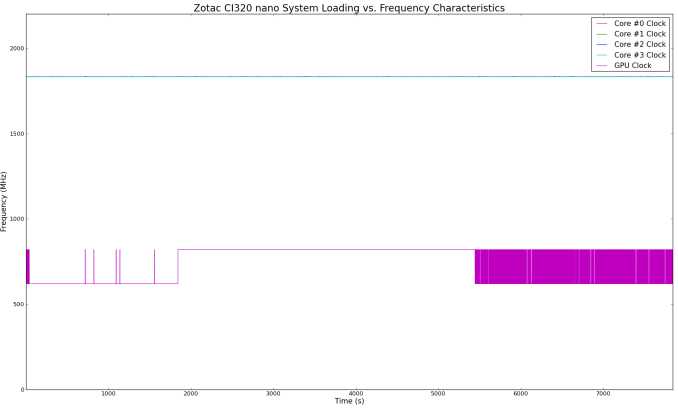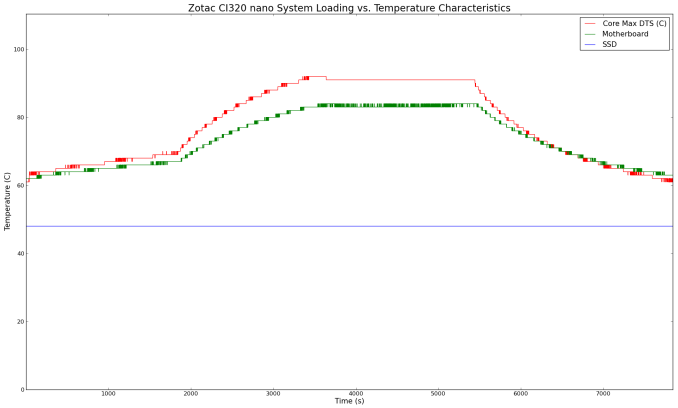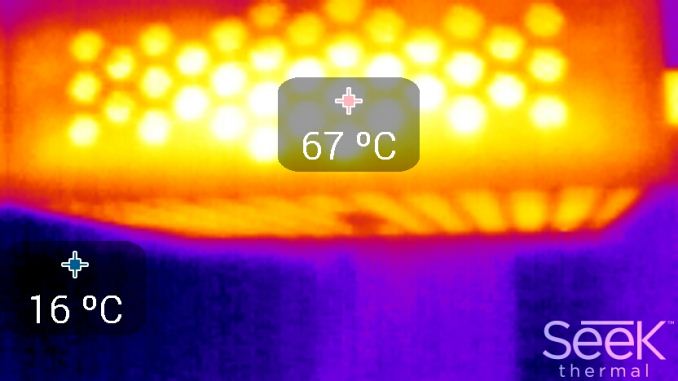Zotac ZBOX CI320 nano Review: A Fanless Bay Trail-M mini-PC
by Ganesh T S on January 6, 2015 10:00 AM ESTPower Consumption and Thermal Performance
The power consumption at the wall was measured with a 1080p display being driven through the HDMI port. In the graphs below, we compare the idle and load power of the Zotac ZBOX CI320 nano with other low power PCs evaluated before. For load power consumption, we ran Furmark 1.12.0 and Prime95 v27.9 together. The numbers are not beyond the realm of reason for the combination of hardware components in the machine.


Reasonable power aside, there does seem to be a BIOS default configuration issue causing the idle power to be a bit on the high end. One of the possible reasons was revealed in our evaluation of the thermal performance (discussed below).
The various clocks in the system as well as the temperatures within the unit are presented below. We start with the system at idle, followed by 30 minutes of pure CPU loading. This is followed by another 30 minutes of both CPU and GPU being loaded simultaneously. After this, the CPU load was removed, allowing the GPU to be loaded alone for another 30 minutes.
A look at the frequencies above indicates that all the cores are pegged at 1.83 GHz throughout our evaluation (even at idle). On the other hand, the GPU frequency varies between 600 and 800 MHz depending on the GPU load. The junction temperature of the Celeron N2930 is 100 C. The cooling system is efficient and manages to keep the SoC temperature below 93 C even under extreme duress.
Another important aspect to keep note of while evaluating fanless PCs is the chassis temperature. Using Seek Thermal's thermal imager, we observed the chassis temperature after the CPU package temperature reached the steady state value in the above graph.
Surprisingly, the chassis temperature was less than 70 C even after heavy loading. Though this is not as low as the 56 C we observed in the CA320 nano, it is better than the 75 C+ that we saw in the CI540 nano.













44 Comments
View All Comments
tential - Tuesday, January 6, 2015 - link
Yes for small machines like this the benchmarks are nice, but we need to have in the "Final Words" section some notes about their usage of this machine. Because the benchmark doesn't tell me if using Office/WebBrowsing feels alright or not.I'm VERY happy though that they started doing XBMC testing and to find this PC handles it perfectly. I'm curious to see how this would be priced without Windows so I could make it a dedicated XBMC machine.
jimbo2779 - Tuesday, January 6, 2015 - link
The price listed is already the price without the OS. It came with no OS and they had to install it themselves.bsd228 - Tuesday, January 6, 2015 - link
Windows with Bing is free for computers < $250. Basically they don't want to lose that business to Chrome.074geodude - Tuesday, January 6, 2015 - link
I'm starting to see a rise in popularity of low cost ($200 or less) miniPCs. At CES 2015 HP just announced the $180 Stream Mini. Gone will be the days of huge bulky desktops sitting on top of your desk. Now we'll have pocket-sized PCs at every monitor or TV that are capable of doing the daily tasks that most consumers need, like Office/web-browsing/streaming video.Solandri - Tuesday, January 6, 2015 - link
I would argue that most everyone already has a pocket-sized PC in their pocket - a smartphone. And all that's needed is a straightforward way to interface it with an external monitor/TV and keyboard/mouse any time you want to use a "PC" at a desk. Microsoft realizes this, which is why they are pushing Windows Phone and were pushing Windows RT. Intel realizes this, which is why they're concentrating on power savings and mobile processors (to take on ARM), rather than trying to push high-end performance.t.s. - Wednesday, January 7, 2015 - link
Agreed!Solandri - Tuesday, January 6, 2015 - link
That is exactly what the PCMark benchmarks on page 2 are for. They do a bunch of things which simulate home, office, or creative tasks and boil it down to a single number.http://en.wikipedia.org/wiki/PCMark
kmmatney - Tuesday, January 6, 2015 - link
The benchmarks I see are video encoding, compression, and some photoscan benchmark. Not really the same as using it as an office computer. It would also be nice to see these systems compared to a cheap desktop system with a Celeron or Pentium.silverblue - Wednesday, January 7, 2015 - link
I'd like to see a test that exposes the JPEG acceleration in Temash/Kabini; surely a valid usage scenario given the image-heavy nature of the Internet.Both the CI320 and CA320 confuse me. The former is hamstrung by having only one DIMM (Bay Trail supports dual channel at 1333MHz) and the latter has an astonishingly pedestrian CPU but actually costs more to buy. The top Mullins APU is far faster and wouldn't use any more power, so perhaps we'll see one in the not too distant future? Also, adding in an extra DIMM to the CI320 to test for any difference in performance would be very interesting.
Libertysyclone - Tuesday, January 6, 2015 - link
I see there is a spot for an IR sensor, is that built in? I didnt see it on the specs sheet